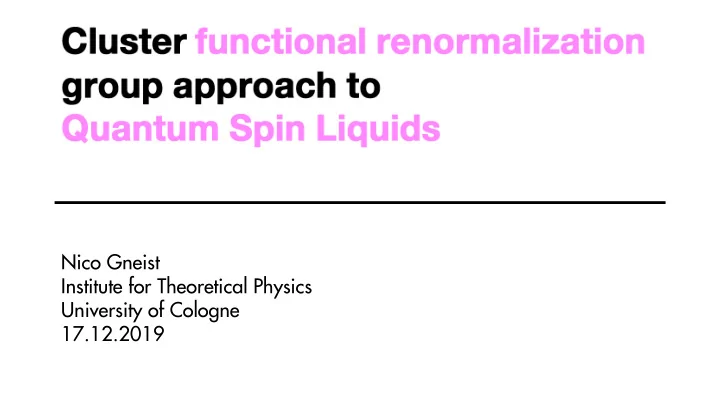

Nico Gneist Institute for Theoretical Physics University of Cologne 17.12.2019
? Magnetic frustration prevents magnetic order!
Topological frustration → no magnetic ground state Analytical solution → introduces fractionalization
Decompose Spin into 4 Majoranas Majorana in condensed matter: real and imaginary part of fermion Enlargement of Hilbert space calls for local constraint
Recombine Majoranas to gauge fields New Hamiltonian Find useful quantity to diagonalize Hamiltonian in a specific gauge sector
Plaquettes operator: +1 +1 Lieb theorem: Ground state is in sector with all plaquettes +1 ( or -1) +1 +1 Solution
1. Spin system with non-magnetic but also non-trivial ground state 2. Fractionalization: new elementary excitations carry only fraction of the quantum number of former excitation ? Balents/Savary, Wen: QSL is quadratic in fractionalized d.o.f
How to get physics: path integral Or: : microscopic action : effective action (generator of 1PI diagrams) Solving path integral usually not possible!
Physics on Physics on macroscopical scale microscopical scale : interpolates between scales! (Wetterich, 1989) Shell-integration corresponds to solving the flow equation
Reminder: we want an effective description in fractionalized dofs! ? „ Allow “ system directly to have fractionalized degrees of freedom: use Abrikosov fermions directly for microscopic action and then use FRG FRG
Yes! PF-FRG, a FRG method base on the same decomposition already exists! Works well for determining phase boundaries Applicable for large variety of spin systems Works in 2D & 3D Now: which QSL in the specified area?
SU(N) MODEL
i. Decompose SU(N)-spin into fermions ii. Impose constraint iii. Decouple via Hubbard-Stratonovich Treat model in large N at first!
→ ∞ iv.In large N, constraint not necessary Ansatz: (Arovas, Auerbach 1988) v. Two QSL phases in large N BZA: π π π -Flux:
→ ∞ i. Equip action with running coupling Phase transition of bilinear order parameter! ii. Use Wetterich equation to derive β -function for running coupling ? iii. Solve β -function from UV to IR
→ ∞ T=0.1 Add order parameter explicitely → enable flow into broken phase (Salmhofer et al. 2004) Does only work if correct order Suspect from mean-field: parameter is added New ansatz: New β -functions :
→ ∞
→ ∞ Recap order parameter: Order parameter is fixed on each bond! π π π -flux requires non-uniform bond values, e.g. Introduce anisotropic order parameters by clustering
4 Sublattices: ABCD, eg. Example of new order parameter: Same for and
→ ∞ INITIAL INTERACTION SYMMETRY BREAKING TERM GENERATED INTERACTIONS
π → ∞ π
→ ∞
J – J 1 2 MODEL
→ ∞ Implementation: completely analogous to former model , „just“ with a few more couplings Result: BZA and Pi-Flux phase existing also in the new model in large N Question: What happens N=2?
Question: What happens at N=2? QSL? Neél Collinear Difficulty: implement constraint!
Problem: constraint not negligible! Spins → Fermions Solution: Popov-Fedotov chemical potential → Filters unphysical states on level of the partition function
Implement Cluster FRG for model while … … using bilinear QSL order parameters … … using clustering to enable Pi-Flux phase … … using chemical potential to impose constraint… Result: No magnetic order No bilinear order parameter can regularize the divergence There is no (bilinear) spin liquid in this model! Suggestion: Non-blinear order (plaquette?)
Development of novel approach to identify spin liquids Approach is unbiased Succesfully benchmarked at a known result First result: no spin liquid in the J -J model 1 2 Under construction: implement method for Kitaev model with complex fermions
Recommend
More recommend